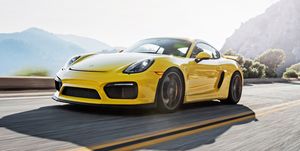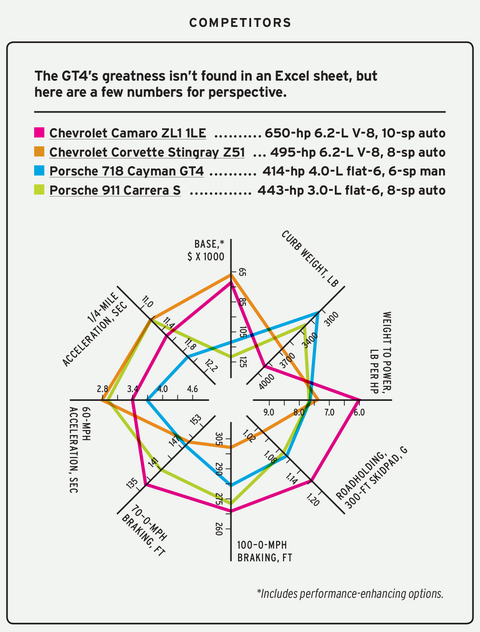From the June 2020 issue of Car and Driver.
Emotion is often collateral damage to the grind of technological progress. We’re not implying that cars have feelings—at least we wouldn’t say it publicly, because that’s a fast track to a padded room—but the best cars stir emotion in their drivers.
But damn it, even though they can spin at more than 100,000 rpm, turbos aren’t great at stirring emotion. The way they square off (and, yes, loft) torque curves and muddy exhaust notes tends to homogenize something so important to vehicular identity. Rather than engines having the distinct character of an inline-four, a flat-six, or a V-8, turbos have a way of reducing the critical specifications to just torque output. They push cars away from individual personalities and toward conformity.
So when you hear the Porsche 718 Cayman GT4’s naturally aspirated flat-six howling toward 8000 rpm, you find yourself taking a deep, refreshing breath. The hairs on the back of your neck stand up, goose bumps trickle down your spine, and—thanks to the dynamic powertrain mounts that firm up when the car is pushed—the frenetic vibrations of the 4.0-liter behind your back course through the car. This thing around you feels alive.
The flat-six at the heart of this car, while it displaces 4.0 liters like the one in the temporally discontinued 911 GT3, is not at all related to that engine. Instead, it is a naturally aspirated development of the twin-turbocharged family that powers the 911. Porsche did a lot more than just pull off the snails before shoving it into the 718, though. Increases in bore and stroke swell displacement by a liter, and the heads, manifolds, crank, and other internals are new. Cylinder deactivation shuts down one bank under light load, alternating banks every 20 seconds to balance wear. Does it work? Can you feel it? On the highway, the activation sounds a bit like an exhaust leak, which led us to reflexively disable it by deactivating the stop-start system at startup. This comes with the added joy of listening to a naturally aspirated flat-six’s raspy idle.
The 4.0 reaches its 414-hp peak at 7600 rpm and makes 309 pound-feet of torque at 5000 rpm, hitting the rev limiter at 8100 rpm. That’s an increase of 49 horses over the most powerful four-pot Cayman and no gain of torque, but there’s a world of difference between four turbocharged cylinders spinning a crankshaft and six cylinders breathing atmospheric pressure unencumbered by turbo plumbing. The brute force of turbochargers is undeniable, but the linear crescendo of output and the shriek of the six are vastly more engaging. There’s finer control here than in most turbo cars, with palpable differences between squeezing and stabbing the accelerator.
The engine differences, though, only toe into the gulf between the GT4 and the rest of the 718 family. The bits separating this most extreme example from other Boxsters and Caymans are the same ones linking it to other GT Porsches. If you think of this as a GT3 chassis transplanted into Porsche’s mid-engine car, you’re not too far off. The front axle is shared between the GT3 and GT4, as are many components of the rear suspension.
A stock 718 Cayman is far from a donk, but the GT4 sits 1.0 inch lower on a stiffer suspension. That and its more aggressive front fascia and manually adjustable wing give it an awesome predatory look—fitting for something named after a member of the alligator family. It’s not just for the sake of appearance, either. The aero package on this car is good for 50 percent more downforce than the last-gen GT4 but with virtually no effect on drag. Much of the credit goes to the redesigned muffler that opened up space for a functional diffuser, which contributes about 30 percent of the downforce on the rear axle.
The GT4 moves like a predator, too. All the lowering and stiffening results in a car with reflexes so quick, it might as well be part of your central nervous system. The steering reacts to the tiniest finger flex and facilitates unprecedented intimacy with the road. The pavement confides in you about that overloaded gravel truck that went by last March and the harsh freeze-thaw cycle in the spring of ’13.
But the GT4 bends that world to its will, its Michelin Pilot Sport Cup 2s clinging to the road like an alligator to its prey in a death roll. Increasingly, the industry is producing cars that can’t be fully exploited on public roads—cars that need a racetrack. We’d set that threshold at about 500 horsepower, not because it’s all about acceleration, but because cars with limits that high tend to have similar outputs. But the GT4 made us reconsider that scale. It’s not just power. It’s the ratio of weight to power, and each of this Cayman’s 414 horses is responsible for just 7.6 pounds. For reference, a 526-hp Ford Mustang Shelby GT350 has 7.3 pounds per horsepower.
But the meathead Mustang can’t even keep up with this svelte GT4 in a straight line. The Cayman hits 60 in 3.7 seconds, shortly after the shift into second gear. And whereas 11-second quarter-miles were once solely the domain of the all-wheel-drive 911 Turbo, this rear-driver trips the lights in 11.9 at 120 mph. Its handling limits are even less street-friendly, as a 1.10-g skidpad performance equates to doubling or even tripling recommended speeds on freeway cloverleafs. A 148-foot stop from 70 mph corresponds to thoracic bruising and significant next-day neck pain.
More than anything else, the $5900 Full Bucket seats seem to exist to facilitate such bruising. They will be instruments of torture for most people and best left to Instagram “fitness models” and other masochists. After just a couple hours in them, our toes started to go numb and our hips felt as if they’d been hammered with a meat tenderizer. A mild panic that we were never going to be comfortable again set in. If you see a GT4 parked on the side of the road and the owner walking, it’s not necessarily because the car’s out of gas. The driver might just need a break.
But the GT4 is otherwise something you’ll want to binge. That steering is just the beginning. Every primary control is a lesson in perfection. If there’s an automotive engineer active today developing anything—anything, any model, any type of vehicle—who hasn’t driven a 718, then that person doesn’t really understand what good is. That’s how perfect this car is. The clutch pedal alone is an experience richer than you’ll get from most vehicles in their totality. The sole of your foot detects the graining on the disc as you let the pedal out. And there are few, if any, better shift levers on the market. The weight, the certainty of its movements, the spacing of the throws—it’s the pinnacle of automotive evolution. As far as manual transmissions are concerned, it’s time now for a rapture—or a meteor strike.
The GT4 is not the Cayman for everyone. Depending on road conditions where you live, its ride may be too harsh as a daily driver. The GT4 is not happy merely puttering about. On the highway, the Michelins thrum and reverberate over impacts, the exhaust drones, and the engine whirs behind your head. The steering requires constant attention, and even small ruts and bumps jostle occupants. Under part throttle, there’s a little vibration through the structure from the engine. The whole car is just so taut, so tightly strung. But this is not a negative. It’s a reminder of what a real, raw experience you’re having. Because that’s what this is: an experience. The Cayman GT4 feels alive. Heck, it’s more alive than most people—certainly more alive than the ones who don’t love dogs. It makes you want to call someone you haven’t spoken with in too long and tell them you love them. And then get them in the passenger’s seat and go do something extremely dumb and illegal. Get carried away. That’s what emotional beings do, and it’s what emotional cars encourage.
Counterpoints
With the 992, Porsche continued the 911’s pivot from a sports car just comfortable enough for everyday life to a grand tourer that does a believable impression of a sports car. That leaves the 718 line to carry on the old 911’s ethos, and boy, does this GT4 do just that. The GT4 achieves its greatness by channeling its great-granddad, the 997 GT3. Both cars feature 400ish-hp flat-six engines that rev past 8000 rpm, a manual trans, and all the tactile feel one might ever want. Four wheels and an engine doesn’t get better than this. Certainly not for $100K. —K.C. Colwell
The GT4 oozes driver involvement and tickles all the right senses, plus a few awkward ones. The one-piece bucket seats look racy and do their job, but they’re only good for daily use if your commute passes through Sebring or Lime Rock. The seatback angle doesn’t adjust, and the aggressive thigh bolsters require acrobatics before you can settle into the seat. Drop in too early and the rigid thigh support delivers a surprise prostate exam. Plus, the $5900 pocketed by not optioning the race seats will be money well spent on tires and track days. —David Beard
Want more Car and Driver?
Subscribe Now!
Source: Reviews - aranddriver.com















